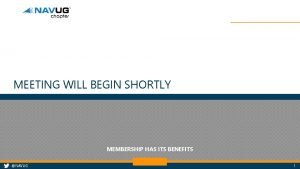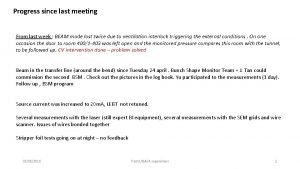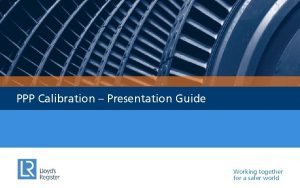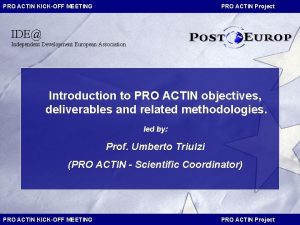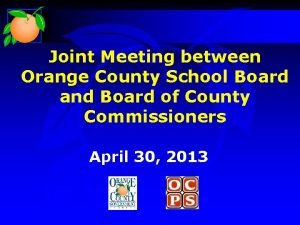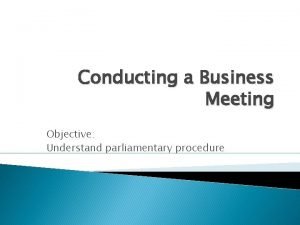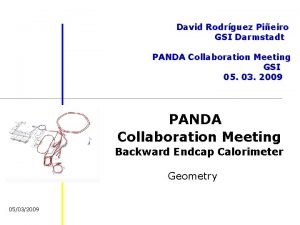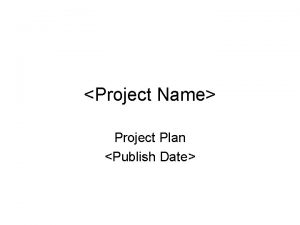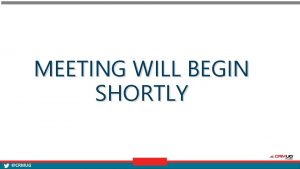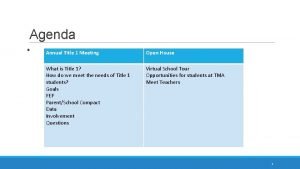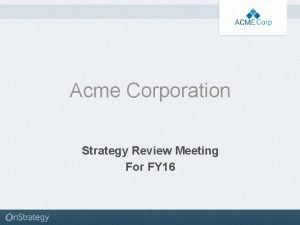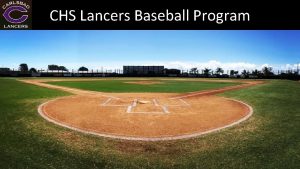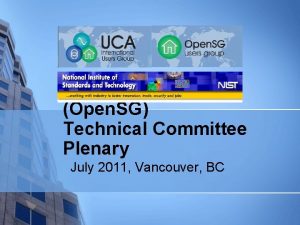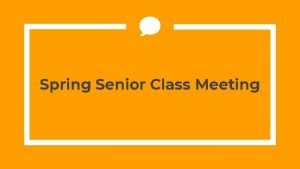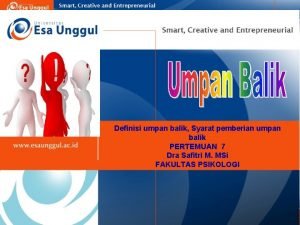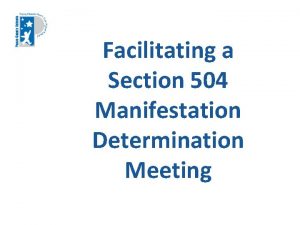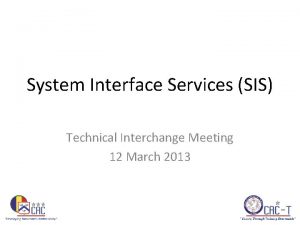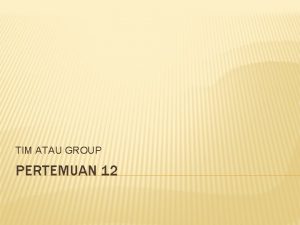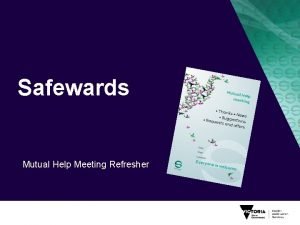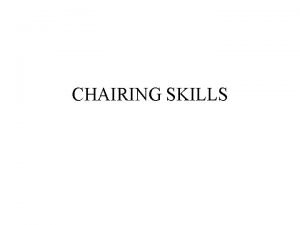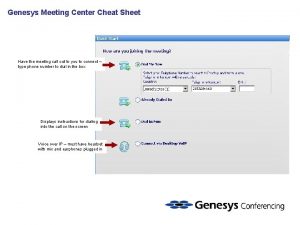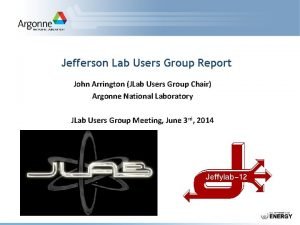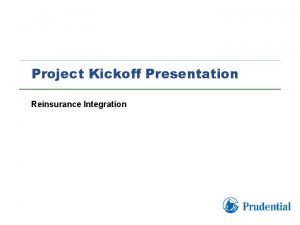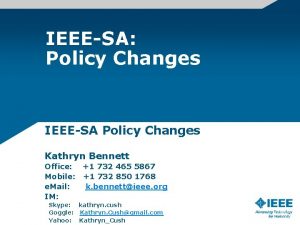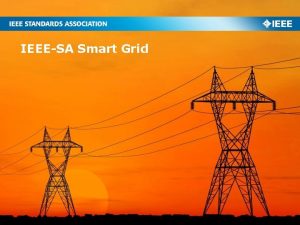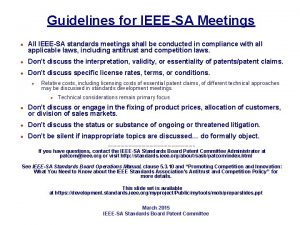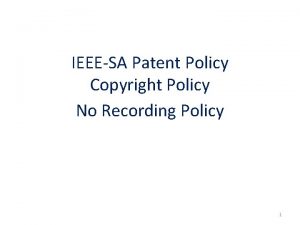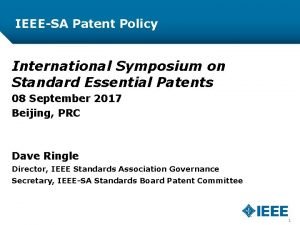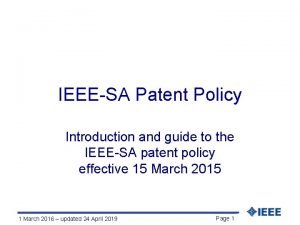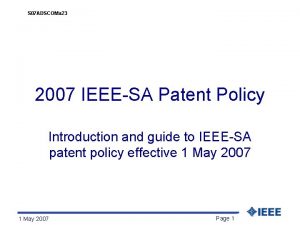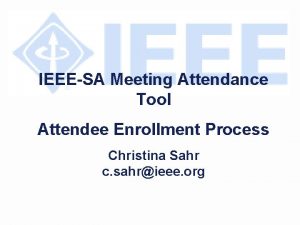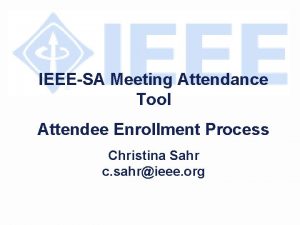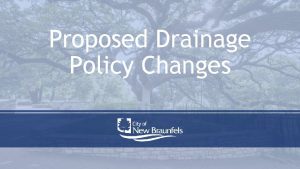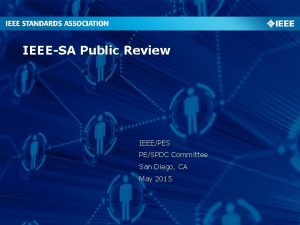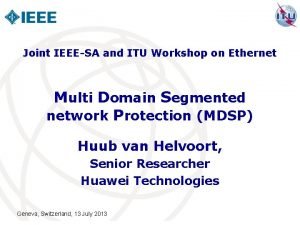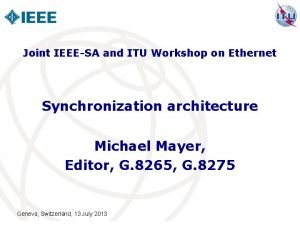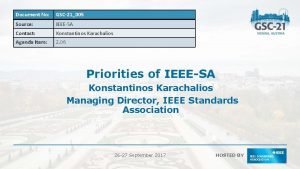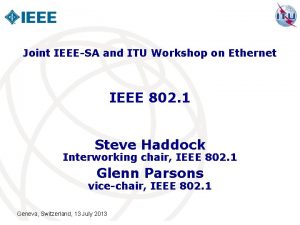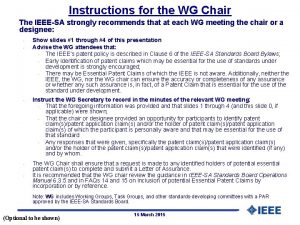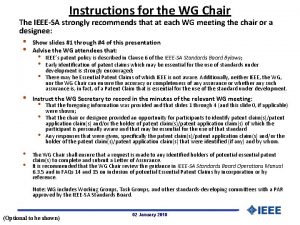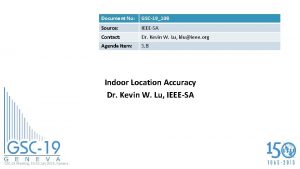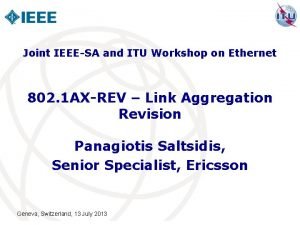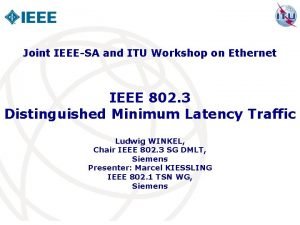IEEESA Policy Changes IEEESA Policy Changes PESICC Meeting


































- Slides: 34

IEEE-SA: Policy Changes IEEE-SA Policy Changes PES-ICC Meeting Malia Zaman March 27, 2012

Policy Changes Reaffirmation/Stabilization Interpretations ANSI Balance Rule Invited Experts Match Rule Public Notice/Patent Disclaimer 2 12/21/2021

Reaffirmation/Stabilization 3 12/21/2021

New Process for Maintaining Active Standards In June 2011, the IEEE-SA Board of Governors (Bo. G) and Standards Board (SASB) approved a new process for maintaining active standards. • Changes are reflected in the policies and procedures: • SASB Bylaws • • SASB Operations Manual • 4 The changes are available online at http: //standards. ieee. org/about/sasb/procom/reaffchanges. pdf 12/21/2021

Benefits The IEEE-SASB, which is comprised of appointed volunteers who oversee the standards development process, determined that it was important to: • Streamline/simplify the maintenance process to assist participants in complying with the policies and procedures of both IEEE and ANSI • Offer Sponsors and Working Groups additional time to review and complete a revision cycle • Enable Sponsors to focus on revisions of standards that require maintenance action, rather than a diffusion of Sponsor efforts to meet administrative requirements for reaffirmation or stabilization • Have a process that permitted a standard to be revised when addressing comments during maintenance so that IEEE standards will remain pertinent and of high technical value 5 12/21/2021

Rationale Various options were considered and it was determined that the new process: • Was simplest and least taxing on volunteer resources • Allowed standards developers to concentrate on keeping IEEE standards relevant • Reduced IEEE’s legal risk associated with outdated standards by making needed revisions where warranted by the Sponsor, Working Group, and Sponsor Balloting Group 6 12/21/2021

Changes Effective Jan 1, 2012 • There will be no new reaffirmation or stabilization ballots • The only actions available to Sponsors will be: • Revision • Amendment/Corrigendum (does not impact maintenance cycle) • Withdrawal • Standards will have a 10 year maintenance cycle (i. e. , extended from 5 years to 10 years after the last date of approval or maintenance action) • The status for a standard will be either active or inactive • All standards must have a revision approved by the IEEE-SASB prior to the close of Year 10 in order to remain active 7 • Any standard not approved as a revision will become inactive after Year 10 12/21/2021

Categories of Inactive Standards inactive-superseded: These standards have been replaced with a revised version of the standard, or by a compilation of the original active standard and all its existing amendments, corrigenda, and errata. inactive-reserved: These standards are removed from active status through an administrative process for standards that have not undergone a revision process within 10 years. inactive-withdrawn (valid for standards categorized after 1 January 2012): These standards have been removed from active status through a ballot where the standard is made inactive as a consensus decision of the balloting group. 8 12/21/2021

Revisions A revision ballot may result in: • Changes to the standard • Changes to only the references or bibliography • No changes at all 9 12/21/2021

Reaffirmation/Stabilization Transition Plan A. Standards reaffirmed/stabilized prior to 1 Jan 2012 – use the latest of the following dates to complete the revision process or standard will be transferred to inactive status: • By 31 December 2018 – 7 years after start of new program, or • 10 years from initial approval, or • 10 years from last maintenance action B. Reaffirmation/Stabilization in invitation/ballot on 1 Jan 2012: • 1 year to complete (approved at the December 2012 SASB meeting) • If not completed by 31 Dec 2012, then item A applies C. No new reaffirmation/stabilization invitations permitted after 31 Dec 2011 10 12/21/2021

Input from Users of a Standard Users (those who use or implement a standard) can notify Sponsors or the IEEE if they believe a revision should occur prior to 10 years: – 1) In the front matter of each standard, users are notified that they can contact the Secretary of the IEEE-SASB to submit issues/concerns – 2) Users can contact the Sponsor directly online, or can contact a Staff Liaison who would be able to provide contact information or pass along the issues/concerns to Sponsors – 3) Sponsors can revise, amend or withdraw their standards at any time prior to Year 10 – 4) An inaction on the Sponsor's part can be appealed to the IEEESASB where an appeal hearing can be performed 11 12/21/2021

American National Standards An ANS can be revised prior to Year 10 if deemed appropriate • Any standard that is currently an ANS will need to report to the administrator of the Standards Review Committee (Rev. Com) during Year 5 and explain whether a revision is in progress, or whether a revision is slated to be completed within the next 5 years • IEEE has informally submitted the procedural changes to ANSI. No objections were obtained. The updated policies and procedures will be submitted to ANSI for audit in early 2012 along with all other 2011 procedural changes. • 12 12/21/2021

Interpretations 13 12/21/2021

Elimination of Interpretations The IEEE-SA Standards Board approved a proposal to eliminate issuing interpretations in June 2011 • Current practice: Interpretations should not constitute an alteration to the original standard – At present, they are permitted to provide meaning to text that is ambiguous • 14 12/21/2021

Interpretations - Rationale • Inefficient and a risk – Interpretation responses made in an attempt to clarify ambiguous text to be derived from a process that does not inform all materially interested parties of the activity – Does not require consensus to be achieved through the Sponsor balloting process 15 12/21/2021

Interpretations - Solution • More sensible to simply funnel comments on standards to Sponsors for handling – Any document changes would appear in a revision amendment/corrigendum – All require PARs – an open process & consensus through balloting • 16 Therefore interpretations as discrete documents should be discontinued 12/21/2021

Interpretations – Going Forward • Elimination of Interpretations – In order to maintain ANSI accreditation, we are required to have an interpretations policy. § Our interpretations policy can be that we do not supply Interpretations Changes will be effective 1 January 2012 • Changes to Ops Man, By. Laws, etc • – “The IEEE does not offer interpretations of its standards” 17 12/21/2021

Balance Rule 18 12/21/2021

ANSI Essential Requirements. Balance Rule ANSI Essential Requirements require that interest categories for “safetyrelated” standards balloting can not be greater than 1/3 of balloters ANSI’s audit of IEEE-SA’s procedures for 2009 determined that – IEEE SA’s current rule that balance is achieved if no one classification is 50% or more 19 12/21/2021

ANSI – Balance Rule “Safety Standard” was not defined or included by ANSI’s rule IEEE left with three choices – Adopt the 1/3 rule across the board – Define “safety standards” – Implement the 1/3 rule if the word “safety” was included anywhere in the document 20 12/21/2021

ANSI – Balance Rule Resolution Changing the ANSI Essential Requirement would be difficult After significant deliberation, the Standards Board approved a motion: – Balance will be achieved by not permitting any single interest category to comprise more than 1/3 of the Sponsor balloting group Other categories can be considered beyond user, producer, general interest, etc. 21 12/21/2021

ANSI – Balance Rule Going Forward Changes to IEEE- SASB Ops Man to be implemented 1 March 2012 A Standards Board Ad. Hoc will continue to create education material and to address implementation issues 22 12/21/2021

Invited Experts 23 12/21/2021

Invited Experts - Elimination Prior to 1998, IEEE membership was required to ballot on an IEEE standard – IEEE membership requires certain technical/educational credentials § Having invited experts beneficial then 1999 IEEE-SA created & IEEE membership no longer needed, just IEEE-SA – No technical/educational credentials 24 12/21/2021

Invited Experts – Going Forward Invited Experts in IEEE’s balloting process is no longer needed – Anyone can qualify for membership or can pay the per-ballot fee Removing Invited Experts will create an equal participation field for all those interested in an IEEE ballot Effective 1 January 2012 “Invite an Expert” will not be available 25 12/21/2021

Match Rule 26 12/21/2021

Match Rule - Elimination Current Practice: Title/Scope/Purpose of the PAR for new and revision projects must match that of the draft document Proposed change: Update ballot announcement in my. Project to make it clear that one of the balloters responsibilities is to ensure that the scope of the draft is within the scope of the work authorized by the PAR 27 12/21/2021

Match Rule - Rationale If the scope of an approved standard were to go beyond the scope of the PAR – Materially interested persons may not have the opportunity to participate § Fail to meet openness Rev. Com not to make judgment if scope of document is within scope of PAR Match rule created unnecessary Modified PAR requests 28 12/21/2021

Match Rule – Going Forward It is the job of the balloters to determine if the scope of the final standard is within the scope of the work authorized by the PAR – It is okay for the scope of the draft to be less than the scope of the PAR Eliminate the Match Rule on January 1, 2012 29 12/21/2021

Public Notice/Patent Disclaimer 30 12/21/2021

Public Notice/Patent Disclaimer For published documents, at present, there are two options for frontmatter disclaimer language based upon whether or not a patent letter of assurance (LOA) was on file at the time of publication Goal is to have 1 public disclaimer in the document 31 – Avoid the possibility of incorrect statement 12/21/2021

Public Notice/Patent Disclaimer Creation of 1 disclaimer will eliminate: – Miscommunication if an LOA is accepted – Timing of the receipt of the patent LOA if received after a standard is approved – Misunderstanding by implementers as to whether or not they should refer to the patent listing for LOAs Effective January 2012 32 12/21/2021

Questions URL for FAQs: http: //standards. ieee. org/faqs/reaff. ht ml • Malia Zaman, Program Manager Email: M. Zaman@ieee. org Tel: 732 562 3838 • 33 12/21/2021

Thank You! 34 12/21/2021
 Meeting objective
Meeting objective What is meeting and types of meeting
What is meeting and types of meeting What is meeting and types of meeting
What is meeting and types of meeting For todays meeting
For todays meeting Changes in latitudes, changes in attitudes meaning
Changes in latitudes, changes in attitudes meaning Physical change chemistry
Physical change chemistry The meeting will begin shortly
The meeting will begin shortly Since our last meeting
Since our last meeting How to facilitate a calibration meeting
How to facilitate a calibration meeting Pro actin
Pro actin John morris ocps
John morris ocps Objective of business meeting
Objective of business meeting Gsi panda
Gsi panda Un ess meeting
Un ess meeting Asco 2017 virtual meeting
Asco 2017 virtual meeting Meeting project
Meeting project Upload complete ... processing will begin shortly
Upload complete ... processing will begin shortly Title 1 meeting agenda
Title 1 meeting agenda Acme corporation strategic plan
Acme corporation strategic plan Chs lancers
Chs lancers Come together in the morning
Come together in the morning Meeting point
Meeting point Graduation meeting agenda
Graduation meeting agenda Meeting and greeting etiquette
Meeting and greeting etiquette Feedback for meeting
Feedback for meeting Compass points protocol
Compass points protocol Manifestation determination meeting agenda
Manifestation determination meeting agenda Technical interchange meeting template
Technical interchange meeting template Meeting with team
Meeting with team Mutual help meeting
Mutual help meeting Nrg oncology semi annual meeting 2018
Nrg oncology semi annual meeting 2018 Chairing meetings skills
Chairing meetings skills Genesys cheat sheet
Genesys cheat sheet Jlab user group meeting
Jlab user group meeting Wbs includes
Wbs includes






